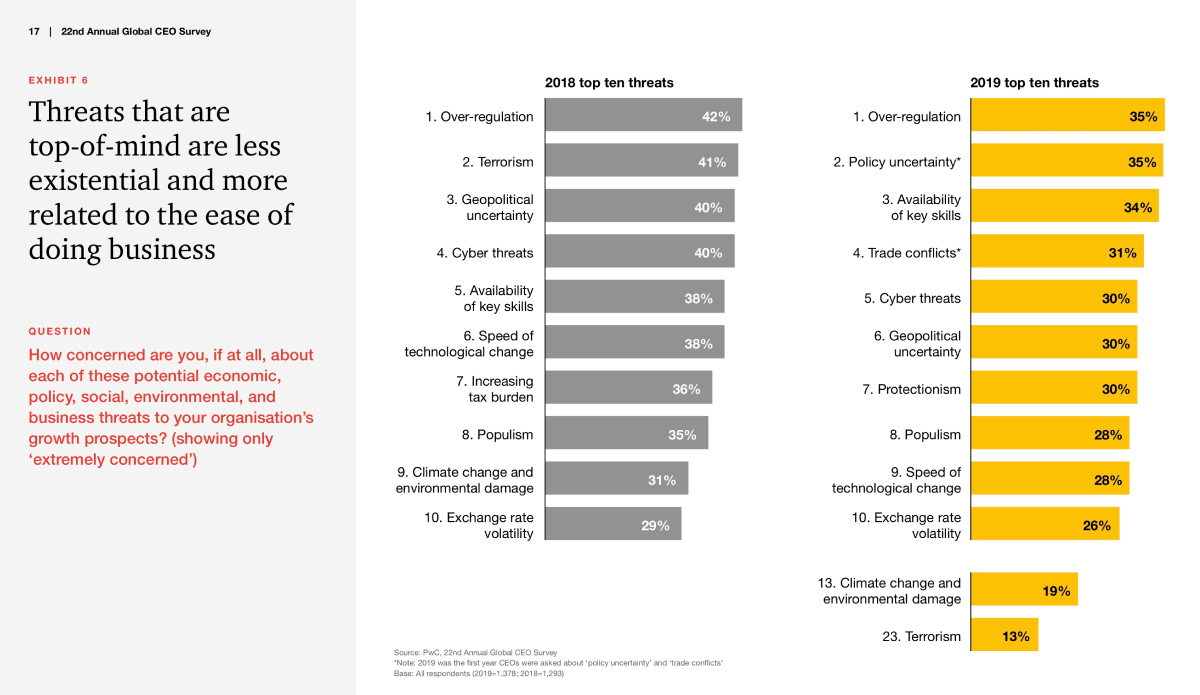Aligning your learning environment with the corporate strategy
How can companies ensure their employees learn what they need to know?

Employee competence is increasingly important for companies. How can you ensure that your employees learn the right things from the company’s point of view?
It’s hardly a surprise that the availability of key competencies is increasingly important for businesses. In PwC’s most recent Annual Global CEO Survey, the chief executives of major corporations ranked the skills gap as the third most significant threat to their company, up from fifth place in the previous year’s survey.
The question of what the most critical skills are and how to ensure their continued availability is the issue we will explore in this article.
Performance metrics reveal bottlenecks…
A company’s strategy defines how it pursues its goals.
As knowledge capital becomes increasingly significant as we shift from an industrial to post-industrial society, training and learning in the corporate setting need to be aligned with each company’s strategy.
Increasing sales or customer satisfaction are common examples of strategic focus areas. A sensible company uses various performance metrics to monitor the achievement of its goals.
For example, if one concrete goal is to increase the number of finalized sales, but the performance metrics indicate that the number is actually declining, the natural next step would be to determine the reasons for the poor performance.
The performance bottleneck may be found in the processes and technologies used—or the people who use them.
If statistics reveal that the company’s sales representatives make lots of customer visits but the conversion rate is low, solving the problem could start from looking at how the sales representatives operate. It could be a competence-related issue.
The situation could be approached by first looking at sales data on operating systems to find out who are the most effective salespeople. When you know who the top performers are on the sales team, you can analyze how they operate. What makes them excellent salespeople?
…and analytics help
An appropriate learning environment makes it possible to use content analytics to determine whether there are similarities between the learning habits of top-performing salespeople.
For example, you could find out what kind of content they have searched for, and whether they read through the material quickly or spend a long time studying it. And, when do they do it? On a daily basis and/or in between work tasks? Once a month? Or when someone tells them to? You can also study the way the top performers collaborate with the work community. How active are they in discussions in the organization’s internal channels? What about external forums? Where do they look for information?
All of these things can be analyzed to try to understand the various components of learning. If you find similarities between the learning habits of your best salespeople, you should actively recommend and disseminate these practices to all of the members of your sales team. This helps the entire team improve and potentially reach the level achieved by the highest-performing individuals through the use of targeted training.
You can also find out whether there’s something that the best performers haven’t done. If you have learning content designed for salespeople but none of your top salespeople have spent any time on it, chances are that the content in question doesn’t support your company’s strategy. That means it is either unnecessary or badly in need of revision.
As these examples show, the analytics provided by a learning platform can reveal potential mistakes in the way learning has been planned. Perhaps someone, some time ago, thought that this particular content could be useful for your company’s sales representatives. Practical experience may later have proven that not to be the case, and this is something that analytics can reveal to you. When the issue is recognized, you can take action to rectify the situation.
Reviewing the usage statistics for learning content is also worthwhile in a broader sense, not just when it comes to your top performers. If the statistical reports produced by the learning platform reveal that certain resources have been used minimally or not at all, you will know that the content in question is not currently helping the company reach its goals. Could that content be highlighted or targeted at specific individuals? If even that fails to make them useful or interesting to your team members, perhaps the content is outdated and ready to be filed away in the archives.
Sorting out your content
An appropriate learning environment makes it possible to determine what the learners are looking for on the system—and whether they are finding it. If you identify a popular search term that has strong relevance to your company strategy but doesn’t produce any results on the platform, you have identified a bottleneck and can introduce new learning material to fill the gap.
You should also evaluate how content is viewed by users. Usage statistics can reveal resources that are frequently retrieved but rarely finished. What’s wrong with those materials, and how can you fix them?

Learning content needs to be actively maintained and updated to keep it fresh. Content that is highly relevant today may not be as relevant five years from now. You can use analytics to find out when the rate of user activity begins to decline or when user feedback for the content starts to deteriorate.
You can also study your top performers in terms of their backgrounds if the relevant information has been recorded on the learning platform. Perhaps the best performers on your sales team share the same academic or training background or some other attribute?
The ability to evaluate employee competence is also useful when a given competence profile has been defined for the team as a whole. Is the team lacking in any specific area of competence? Who has what the team needs? If you can’t find it anywhere in the organization, you need to develop it through training or recruitment.
While the analytics provided by an effective learning platform enable a wide range of assessments, you should always keep the company’s strategy in mind. This means you have to focus on things that are genuinely important rather than minor details that are not significant to the company’s success.
Increasing efficiency
Increasing the efficiency of operations benefits all companies regardless of their strategic priorities. Time is money, and learning is no exception to this rule. Participating in a long training course or having to read through hundreds of pages of an operating manual may be an unproductive use of time, especially if the goal is to learn something rather specific, which tends to be the case in practice.
A state-of-the-art learning environment can be helpful in this regard as well. Models for processing natural language with the help of machine learning can allow you to index video content in such a way that the cognitive search function can answer the learner’s questions by indicating a time stamp for a long video clip to point the learner to the relevant content. This saves time.
Learning is becoming increasingly dynamic—especially in rapidly changing expert jobs. The need for information can arise on short notice, and it may be quite narrow in scope. A pre-determined training plan that’s the same for everyone is not a good fit for most jobs these days.
The need for less-structured training programs and learning paths is obvious. They can be assembled from a pool of learning resources that employees in specific roles can complete based on what skills and knowledge they need to acquire. A learning experience platform naturally supports these types of flexible training paths that consist of dynamic competence goals.
On the ease of predicting the future
The dynamic nature of learning content is also underscored by the fact that the learner’s role in the company can change substantially over the years. People often take on new positions and challenges that call for different sets of skills. An employee promoted to a managerial position, for example, is likely to need leadership training. Ideally, employees should be coached and developed for their future roles as early as possible.
These paths of growth need be taken into consideration in learning. An up-to-date learning environment has learning paths specified for each role in the organization. In training employees, higher priority should be assigned to the learning resources recommended for the individual’s current role as well as their future role. Similarly, content that will no longer be relevant to the employee’s future role can be assigned a low priority.
Of course, you need to recognize the realities of the situation. It’s difficult to know what exactly will be the skill sets required in various roles in working life five years down the road. Perhaps the challenges related to future focus areas can’t be solved through learning alone. However, when technologies change, for example, you do need training related to their use.
The way to lay out a path of future growth is to use analytics to find out what the company’s best employees are doing differently and to make those lessons available to everyone.




